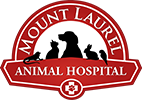Keep Your Pet’s Teeth Clean, Healthy & Strong

Top 5 Signs Your Pet Needs A Dental Exam
Just like you, your furry friends need to visit a veterinarian at least once a year for a dental check-up. Here are some signs that you should schedule a visit as soon as possible:
- Bad Breath (Halitosis)
- Broken or Loose Teeth
- Oral Pain/Pawing at mouth
- Plaque or Tartar Buildup
- Inflammation or Bleeding
Primary Care at Mount Laurel Animal Hospital
Where Your Pet’s Health Is Our Top Priority
If you are looking for routine dental care services for dogs and cats, look no further. Our highly-skilled doctors will go above and beyond to ensure that your pet’s teeth, gums, and mouth are healthy.
By bringing your pet in for evaluation, you can help prevent tooth loss, oral pain, halitosis, and bacterial buildup that can lead to organ damage, and periodontal disease.


Our Services:
Our primary care doctors can examine your pet at a regular wellness appointment or sick exam and create a specific dental treatment plan. This may include a special diet, discussion of appropriate chew toys, brushing regime and setting up a dental procedure.
Our team is experienced at routine dental procedures including comprehensive oral examinations, interpretation of dental radiographs, surgical extractions, scaling and polishing.
For advanced procedures we may recommend referral to a board certified veterinary dentist.
Dental Procedures:
Dental procedures in dogs and cats require general anesthesia. This is the safest way to assess the teeth, take x-rays and perform a complete dental scaling and polishing. In patients with diseased teeth (abscesses, loose teeth, broken teeth etc.) local anesthesia is administered and surgical extractions are performed. This involves creating a flap in the gingival (gum) tissue, drilling out the tooth roots and suturing the gingival flap closed. Our top-notch anesthesia team will continuously monitor your pet’s blood pressure, EKG, and temperature through the procedure to ensure the safety of your pet.
Being away from your pet who is undergoing anesthesia can be stressful especially if you don’t know what to expect. We have created a short video that gives you a unique glimpse into a veterinary dental procedure from start to finish. As you can see, your pet will receive the highest level of care from our experienced team.
Give Your Pet A Healthy & Happy Smile
Does Your Pet Have Bad Breath? It Could Be A Sign Of Illness
Unfortunately, most pets have bad breath, and this is not normal. The foul odor you smell is caused by an infection in their mouth. The most common cause of infection in your pet’s mouth is periodontal disease, which affects over 75% of pets over 2 years of age. Periodontal disease is a progressive and irreversible loss of the structures surrounding the teeth caused by chronic infection and inflammation in the mouth. When your pet eats, residual food particles in the mouth promote growth of bacteria. The bacteria form a slime layer, known as plaque, which attaches to the teeth and hardens to form tartar and calculus.
Early treatment is best to prevent pain, tooth loss and expensive treatments. Left untreated, periodontal disease may lead to:
• Chronic pain from infection and inflammation
• Decreased quality of life
• Decreased appetite and weight loss
• Tooth loss due to loss of supporting tissues around teeth
• Distant organ (e.g.: liver, kidneys, heart valves) damage from bacteria showering from the mouth to the bloodstream
• Adverse behaviors caused by pain
Healthy periodontal tissue is free of infection, inflammation and odor. Keeping the mouth healthy requires a combination of:
• Developing a home dental care plan that works for you and your pet
• Annual to bi-annual examinations by your veterinarian to evaluate the home dental care plan
• Annual professional teeth cleaning. Some breeds (e.g.: small breeds) may require more frequent cleanings.
Just as people need their teeth cleaned regularly, your pet does too
- Daily brushing with pet toothpaste (do not use toothpaste made for people)
- Dental formulated diets, water additives and dental chews
The first step in treating periodontal disease requires cleaning the teeth and surrounding tissues. Because your pet will not lie down quietly for a dental cleaning, general anesthesia is required. To prepare anesthesia, we will do a thorough examination of your pet, perform blood work and discuss the procedure with you. Your pet will be monitored closely throughout the entire procedure: your pet’s safety is our primary concern. After the teeth are cleaned, X-rays will be taken of the teeth to check for pathology hiding below the gum line. We will discuss with you any other procedures that may need to be performed.
Brushing Your Feline’s Teeth
Every cat needs clean, sharp teeth and healthy gums. Damage to the tongue, teeth, palate and gums can lead to many health risks for cats, but these can be prevented with regular veterinary examinations and good old-fashioned tooth-brushing.
Brushing Your Canine's Teeth
Equally important to annual dental exams at your veterinarian’s practice is home dental care, including brushing your dog’s teeth every day if possible. This is much easier if you begin brushing their teeth from a young age.
VIDEO TUTORIAL
